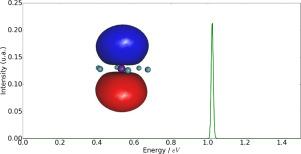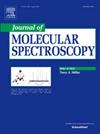Investigating the temperature dependence of photoelectron spectra in KArn clusters: Insights into stable structures and spectroscopic properties
IF 1.3
4区 物理与天体物理
Q4 PHYSICS, ATOMIC, MOLECULAR & CHEMICAL
引用次数: 0
Abstract
In this article, we investigate the temperature dependence of the photoelectron spectrum of a potassium atom adsorbed on argon clusters (n ). We employ a combined Monte Carlo (MC) method with basin-hopping global optimization to simulate the geometries of the argon clusters in the excited 4p state at temperature . Our ab initio model utilizes appropriate pseudopotentials to replace the core electrons of and all electrons of the argon atoms, along with core polarization potentials. Electronic energies and transition dipole moments are calculated for each selected geometry, enabling us to simulate the photoelectron spectrum. Our results highlight the significant impact of temperature on the spectral characteristics of photoelectrons emitted from the system. At a temperature of 5 K, we observe that the stable structures better reproduce the experimental photoelectron spectra. As the temperature increases, we observe broadening and shifting of the spectral peaks, suggesting the successive evaporation of argon atoms. Additionally, the influence of spin–orbit coupling is examined, which may also affect the spectral features and the dynamics following excitation.

研究KArn簇中光电子能谱的温度依赖性:对稳定结构和光谱性质的见解
在本文中,我们研究了吸附在氩簇Arn (n =1−10)上的钾原子的光电子能谱的温度依赖性。我们采用蒙特卡罗(MC)方法和跳槽全局优化来模拟温度t下4p激发态氩簇的几何形状。我们的从头算模型利用适当的伪势来取代K+的核心电子和氩原子的所有电子,以及核心极化势。电子能量和跃迁偶极矩为每个选择的几何计算,使我们能够模拟光电子能谱。我们的结果强调了温度对KAr系统发射的光电子光谱特性的显著影响。在5 K的温度下,我们观察到稳定的结构能更好地再现实验光电子能谱。随着温度的升高,我们观察到光谱峰的展宽和移动,表明氩原子的连续蒸发。此外,研究了自旋-轨道耦合的影响,它也可能影响谱特征和激发后的动力学。
本文章由计算机程序翻译,如有差异,请以英文原文为准。
求助全文
约1分钟内获得全文
求助全文
来源期刊
CiteScore
2.70
自引率
21.40%
发文量
94
审稿时长
29 days
期刊介绍:
The Journal of Molecular Spectroscopy presents experimental and theoretical articles on all subjects relevant to molecular spectroscopy and its modern applications. An international medium for the publication of some of the most significant research in the field, the Journal of Molecular Spectroscopy is an invaluable resource for astrophysicists, chemists, physicists, engineers, and others involved in molecular spectroscopy research and practice.

 求助内容:
求助内容: 应助结果提醒方式:
应助结果提醒方式:


